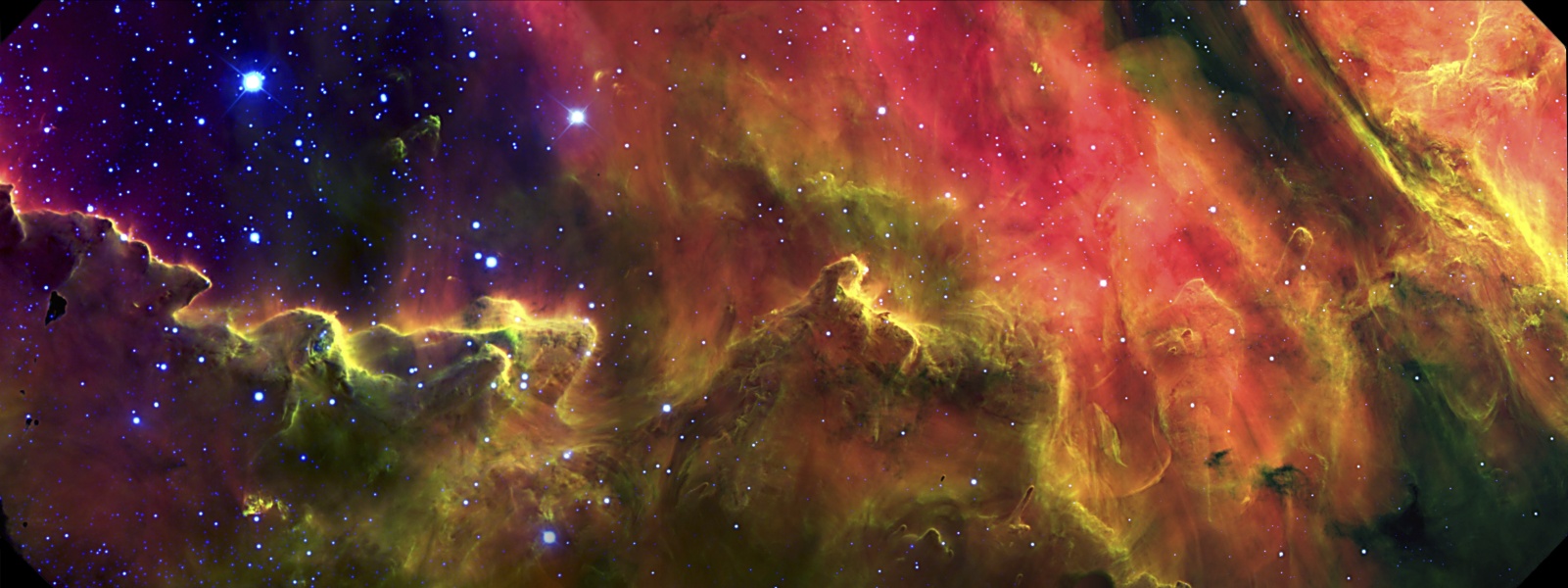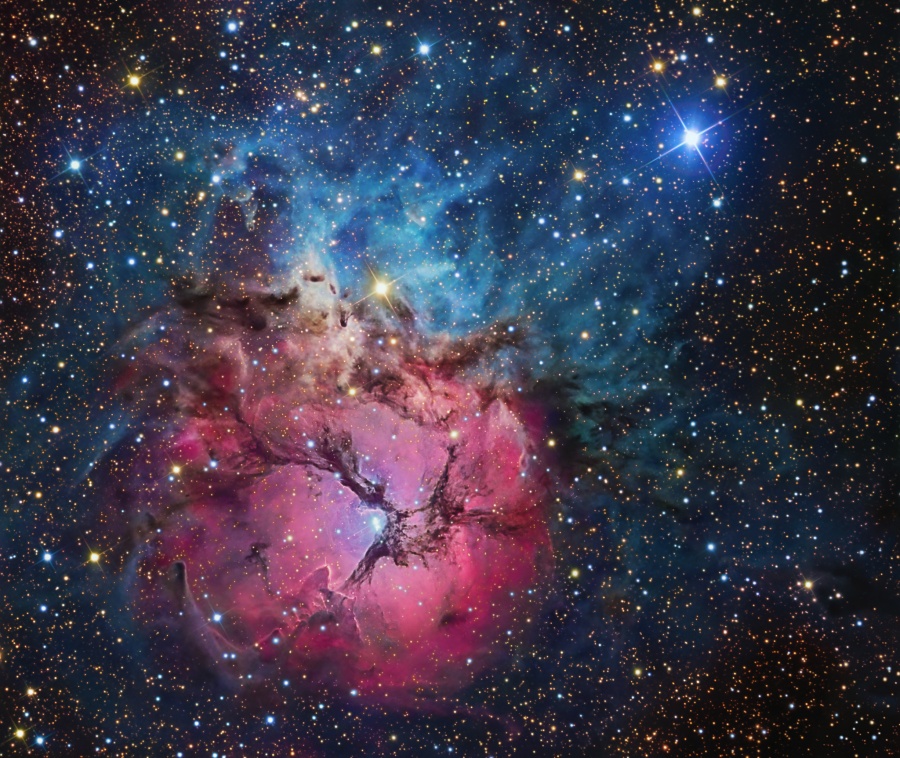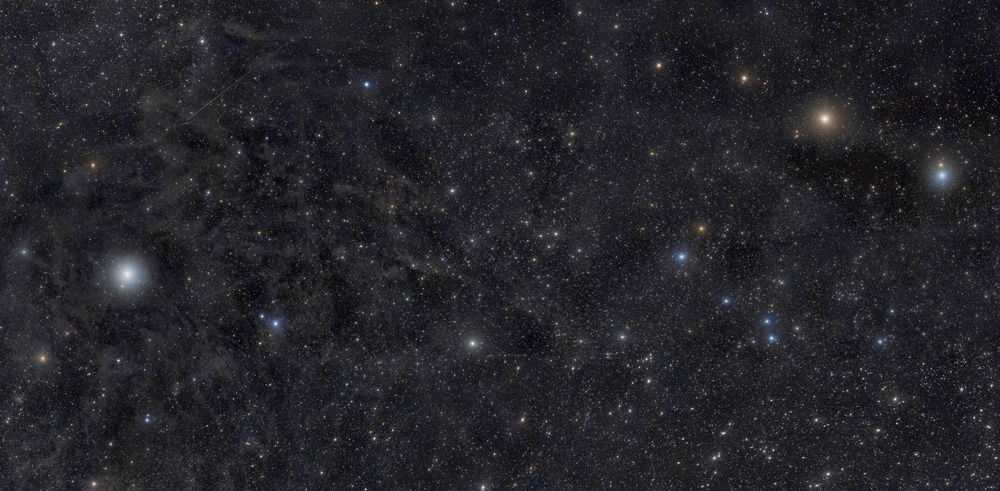_______________________________________________________________
Please vote for the TWO best Astronomy Pictures of the Day (image and text) of May 8-14, 2011.
(Repeated APODs are not included in the poll.)
All titles are clickable and link to the original APOD page.
We ask for your help in choosing an APOW as this helps Jerry and Robert create "year in APOD images" review lectures, create APOM and APOY polls that can be used to create a free PDF calendar at year's end, and provides feedback on which images and APODs were relatively well received. You can select two top images for the week.
Thank you!
_______________________________________________________________
<- Previous week's poll
What's that bright orange dot above the large telescope on the right? Even seasoned sky enthusiasts might ponder the origin of the orange orb seen by scrolling across this panoramic image, taken last December. Perhaps identifying known objects will help. To start, on the far left is a diagonal band of light known as zodiacal light, sunlight reflected off of dust orbiting in the inner Solar System. The bright white spot on the left, just above the horizon, is Venus, which also glows by reflected sunlight. Rising diagonally from the ground to the right of Venus is the band of our Milky Way Galaxy. In the image, the band, which usually stretches dramatically overhead, appears to arch above the elevated Chilean landscape. Under the Milky Way arch, toward the left, lie both the Large and Small Magellanic Cloud galaxies, while toward the right lies the constellation of Orion surrounded by the red ring of Barnard's Loop. On the ground, each of the four Very Large Telescopes is busy keeping an eye on the distant universe. The orange spot -- it's the Moon. The image was taken during a total lunar eclipse when the normally bright full moon turned into a faint orb tinted orange by the intervening Earth's atmosphere.
Does gravity have a magnetic counterpart? Spin any electric charge and you get a magnetic field. Spin any mass and, according to Einstein, you should get a very slight effect that acts something like magnetism. This effect is expected to be so small that it is beyond practical experience and ground laboratory measurement. In a bold attempt to directly measure gravitomagnetism, NASA launched in 2004 the smoothest spheres ever manufactured into space to see how they spin. These four spheres, each roughly the size of a ping-pong ball, are the key to the ultra-precise gyroscopes at the core of Gravity Probe B. Last week, after accounting for persistent background signals, the results were announced -- the gyroscopes precessed at a rate consistent with the gravitational predictions of Einstein's General Theory of Relativity. The results, which bolster existing findings, may have untold long term benefits as well as shorter term benefits such as better clocks and global positioning trackers.
Undulating bright ridges and dusty clouds cross this close-up of the nearby star forming region M8, also known as the Lagoon Nebula. A sharp, false-color composite of narrow band visible and broad band near-infrared data from the 8-meter Gemini South Telescope, the entire view spans about 20 light-years through a region of the nebula sometimes called the Southern Cliff. The highly detailed image explores the association of many newborn stars imbedded in the tips of the bright-rimmed clouds and Herbig-Haro objects. Abundant in star-forming regions, Herbig-Haro objects are produced as powerful jets emitted by young stars in the process of formation heat the surrounding clouds of gas and dust. The cosmic Lagoon is found some 5,000 light-years away toward constellation Sagittarius and the center of our Milky Way Galaxy.
A sunlit crescent of Saturn's moon Enceladus looms above the night side of Saturn in this dramatic image from the Cassini spacecraft. Captured on August 13, 2010 looking in a sunward direction during a flyby of the icy moon, the view also traces layers in the upper atmosphere of Saturn scattering sunlight along the planet's bright limb. Closer to the spacecraft than Saturn, Enceladus is a mere 60,000 kilometers from Cassini's camera. The south polar region of the 500 kilometer-diameter moon is illuminated, including plumes of water vapor and icy particles spraying above the long fissures in the moon's surface. The fissures have been dubbed tiger stripes. First discovered in Cassini images from 2005, the plumes are strong evidence that liquid water exists near the surface of surprisingly active Enceladus.
The beautiful Trifid Nebula is a cosmic study in colorful contrasts. Also known as M20, it lies about 5,000 light-years away toward the nebula rich constellation Sagittarius. A star forming region in the plane of our galaxy, the Trifid illustrates three different types of astronomical nebulae; red emission nebulae dominated by light emitted by hydrogen atoms, blue reflection nebulae produced by dust reflecting starlight, and dark nebulae where dense dust clouds appear in silhouette. The bright red emission region, roughly separated into three parts by obscuring, dark dust lanes, lends the Trifid its popular name. In this well met scene, the red emission is also juxtaposed with the telltale blue haze of reflection nebulae. Pillars and jets sculpted by newborn stars, below and left of the emission nebula's center, appear in Hubble Space Telescope close-up images of the region. The Trifid Nebula is about 40 light-years across.
At 2nd magnitude, Polaris is far from the brightest star in the night sky. But it is the brightest star at the left of this well-composed, starry mosaic spanning about 23 degrees across the northern sky asterism dubbed the Little Dipper. Polaris is famous as the North Pole Star, a friend to navigators and astrophotographers alike, but it's not located exactly at the North Celestial Pole (NCP) either. It's presently offset from the NCP by 0.7 degrees. Sliding your cursor over the picture will locate Polaris and the NCP as well as other stars of the Little Dipper. The stars are shown with their proper names preceded by their greek alphabet designations within the ancient constellation Ursa Minor, the Little Bear. Dust clouds suspended above the plane of our Milky Way Galaxy are also faintly visible throughout the wide field of view.
<- Previous week's poll
Poll: Astronomy Picture of the Week for 2011 May 8-14
Poll: Astronomy Picture of the Week for 2011 May 8-14
A closed mouth gathers no foot.
Re: Poll: Astronomy Picture of the Week for 2011 May 8-14
From this selection, Enceladus and Gravity Probe B are remarkable. The view of Saturn's moon...it lets one be transported to the spot, as it were. And from a larger perspective, Enceladus' environment has unique implications for us, in the evidence pointing to subterranean oceans, the potential for harboring life forms there.
For the Gravity Probe that proved two aspects of the General Theory of Relativity, the experiment was amazing from the scientific point of view: conducting it in orbit, looking for minuscule measurements, the technological inventions to make this possible, the years shifting through data and adjusting error, among other things. There is a practical side also, the expected advances in time measurement and GPS technology. Also, it was nice to find links to a lecture on this site (first time I see this) and to the NASA announcement in YouTube.
For the Gravity Probe that proved two aspects of the General Theory of Relativity, the experiment was amazing from the scientific point of view: conducting it in orbit, looking for minuscule measurements, the technological inventions to make this possible, the years shifting through data and adjusting error, among other things. There is a practical side also, the expected advances in time measurement and GPS technology. Also, it was nice to find links to a lecture on this site (first time I see this) and to the NASA announcement in YouTube.
Re: Poll: Astronomy Picture of the Week for 2011 May 8-14
Celestial, I agree with you! I always have a hard time selecting which APODs to vote for; I usually weight the text -- what I learned from the APOD -- heavily, though am not immune to striking images. Or things in Saturn's neighborhood or Mars (though these are also often striking images  ). This round, it was Enceladus and Gravity Probe B for me, too.
). This round, it was Enceladus and Gravity Probe B for me, too.
A closed mouth gathers no foot.
Re: Poll: Astronomy Picture of the Week for 2011 May 8-14
Thank you for your reply, owlice. I am glad to hear of your selection. As the weeks go by, I notice practice at voting does not make picking two APODs any easier. It does seem, however, one may be inadvertently selecting from the minute one first sees an APOD.





